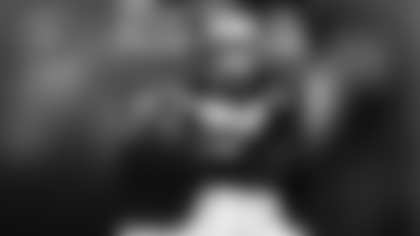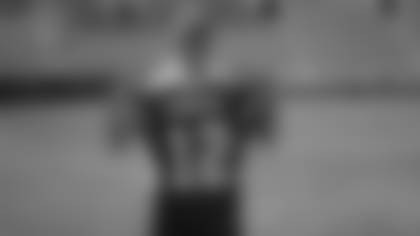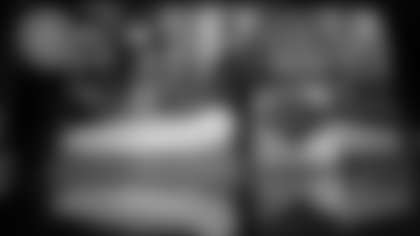Packers team historian Cliff Christl has assembled an oral history series on the NFL Draft, highlighting significant and noteworthy years as a prelude to Green Bay hosting the 2025 draft in late April. New installments will be posted most weekdays. For access to the full series thus far, click here.
2000
The 65th NFL Draft started at 12:05 p.m. (EDT) on April 15, 2000, and ended at 5:35 p.m. the next day with an overnight break. Three rounds were completed the first day with the session ending at 10:59 p.m. The first round took 5 hours, 47 minutes. The final four rounds were held on April 16, starting at 11 a.m. In all, the draft took 16 hours, 25 minutes.
The command center was the Theater at Madison Square Garden.

Fans can now register for free entry to the 2025 NFL Draft by downloading the NFL OnePass app or by registering online!
Tom Brady: "The Prospect"
Going into the 2000 draft, the New England Patriots had never won a Super Bowl and were coming off an 8-8 season, which left them in a last-place tie in the then-five-team AFC Eastern Division.
They also had just changed coaches, firing Pete Carroll after three seasons and replacing him with Bill Belichick, who had a reputation as an assistant for being an Xs-and-Os savant. And yet he was a 37-45 failure in his five-year, onetime stint as a head coach in Cleveland.
From a personnel standpoint, most of the Patriots' offensive players were on the wrong side of 30 and wide receiver Terry Glenn, their most dangerous weapon, had been suspended for the final game of 1999 for violating team policy. The outlook on defense was somewhat brighter with at least four promising starters under the age of 30: end Willie McGinest, linebacker Teddy Bruschi, and backs Ty Law and Lawyer Milloy.
Overall, if there was one position where New England looked set, it was quarterback.
Drew Bledsoe, the first selection in the 1993 draft, was 27 and had finished sixth in the league in passing. The only team in the Patriots' division that was arguably better off at quarterback was Indianapolis, which at that time had a 23-year-old Peyton Manning.
Otherwise, Buffalo's starter was Doug Flutie, 37; Miami's was Dan Marino, who was 38 and expected to retire; and the New York Jets were in no man's land, the result of 36-year-old Vinny Testaverde rupturing his Achilles' tendon in the opener and missing the rest of the season.
Thus, the only reason the Patriots had Michigan quarterback Tom Brady on their radar screen was because their quarterback coach Dick Rehbein had gone to Ann Arbor, Mich., at the request of Belichick, to check him out before the draft and liked what he saw.
Belichick (Hartford Courant, Oct. 23, 2001): "Before the 2000 draft, we sent Dick to see two guys (Louisiana Tech's Tim Rattay was the other). He came back and we said, 'Which guy are we going to take?' He said, 'Brady, this is the guy.' Dick was the strength behind the recommendation and developing him. Tom Brady didn't wake up one day and become a great quarterback."
Pam Rehbein, on what she said her husband told her about Brady upon his return from his scouting trip (Green Bay Press-Gazette, Feb. 2, 2005): "Twenty years from now, people will know the name Tom Brady."
Tragically, Rehbein, a native of De Pere, Wis., died of heart failure at age 45 in August 2001, during Brady's second training camp. Brady himself has never forgotten what Rehbein did for his career. "He had a huge influence and impact on me," he has said.
But it shouldn't be forgotten that Brady, the 199th overall choice in 2000, won his first Super Bowl in his second season, his first as a starter. While his career path has been compared to Green Bay Packers great Bart Starr – the 200th selection in the 1956 draft – there was no comparison.
Starr failed to win a game in his first 19 starts – although the Packers won three of those games when Babe Parilli replaced him and pulled out victories – and didn't secure a starting job until his fifth season, albeit in an offensive system built around the left halfback.
More accurately, Brady's fall in the draft seemed to result from too many first impressions becoming lasting impressions combined with a dose of paralysis from analysis.
Here was a quarterback who started for two years at the University of Michigan, a Big Ten Conference powerhouse steeped in tradition, and compiled a 20-5 record as a starter.
As a senior, Brady was a co-captain; engineered comeback victories over Notre Dame, Indiana, Penn State and Ohio State as the Wolverines won six regular-season games by a touchdown or less; and earned the Bo Schembechler Award as the team's MVP.
He climaxed his four years there by leading Michigan to a 35-34 overtime victory over Alabama in the Orange Bowl. Brady did it by completing 34 of 46 passes for 369 yards with no interceptions, and his fourth touchdown pass proved to be the game-winner. Twice, Brady erased 14-point deficits and his TD passes covered 27, 57, 20 and 25 yards.
A year earlier, in the Citrus Bowl, Brady led Michigan to a 45-31 victory over Arkansas after being down by seven points with less than six minutes to go. At that point, he engineered a 14-play, 80-yard drive to tie the score. Brady finished with 14 completions in 27 attempts for 209 yards and a touchdown, albeit with two second-half interceptions.
Statistically, after his final collegiate game, Brady ranked fourth in Michigan history in career completion percentage, fourth in career passing yards, fifth in touchdown passes and second in lowest interception percentage. In the two categories, where playing time mattered – most yards and touchdowns – four of the five quarterbacks who ranked ahead of Brady were three- or four-year starters.
After both bowl games, Lloyd Carr, the Wolverines' coach, gave Brady ringing endorsements.
Carr, following the Citrus Bowl (Muskegon Chronicle, Jan. 2, 1999): "The measure of a quarterback is not statistics. It's do you win, do you get your team in the end zone?"
Carr, following the Orange Bowl (San Francisco Examiner, Jan. 9, 2000): "Tom Brady is everything you want in a quarterback. The guys around him love him and believe in him, and if you knew him, you'd believe in him, too."
What Brady did at Michigan was basically what he did during his 23-year NFL career highlighted by seven Super Bowl victories.
Exemplified leadership. Consistently won. Played big on the biggest stages. Delivered in the clutch.
Michigan teammate and future Pro Football Hall of Fame guard Steve Hutchinson (Detroit Free Press, Dec. 27, 1999): "Tom is always – no matter if things are going good or bad – he's always the same."
Teammate and center Steve Frazier (Detroit Free Press, Dec. 27, 1999): "Definitely, on the field I have never seen (Brady) rattled. He's always got things under control. He just has a poise, I guess."
What was there not to like about Brady?
"He looked kind of emaciated, with no muscle definition." "He can't run worth a lick." "Lloyd Carr and his staff at Michigan wanted to start Drew Henson." "I wondered about his arm strength."
Those were comments from scouts found at the ESPN and New York Times websites in stories written by Ian O'Connor and Bob McGinn in 2017 and 2019, respectively.
Yes, the widely circulated photo of Brady at his combine weigh-in made it look like he had been on a starvation diet for maybe weeks. But what about the scouting adage that "you can't grow 'em taller but you can make 'em heavier and stronger?"
Yes, Brady ran a 5.28 40-yard dash, the second slowest time among the 18 quarterbacks at the Indianapolis scouting combine. But how often does a quarterback run 40 yards in a game and wouldn't his more respectable times in the 20-yard shuttle and three-cone drill be a better indicator of his ability to step and slide away from a rush?
Yes, Carr's praise contributed to Henson being one of the most over-hyped athletes in recent memory; and he also platooned him with Brady by quarters early in the 1999 season. But even though Carr considered Henson the cat's meow, he never started him ahead of Brady and played him less and less as the season unfolded.
Yes, arm strength is one of the most important considerations in judging a quarterback, but it's also tied to how one stands in the pocket – at 6-foot-4-plus, Brady was the tallest QB at the combine – comes to balance, reads defenses – Brady's Wonderlic score was second best among QBs – and throws with touch and accuracy, all of which Brady needed to work on but with minor tweaking, not a do-over.
Carr, on Henson before his freshman season at Michigan and whose eventual NFL career consisted of nine games and one start (Detroit Free Press, Aug. 28, 1998): "Without question, (Henson's) the most talented quarterback that I've been around."
New York Yankees vice president for baseball operations Mark Newman, on Henson less than two months into his first minor league season and whose Major League career consisted of nine games (New York Times, June 4, 2000): "We are talking about an extraordinary baseball talent here. Drew is not just your everyday good baseball prospect."
While they were harder to find than Henson's drumbeaters, there were scouts and coaches who saw potential in Brady, as well.
Whitey Walsh, former New York Giants scout (espn.com, Oct. 15, 2017): "I always thought you should look at any senior who is starting; maybe they have something. You watch four, five, six plays, and if they don't show anything you leave them off the list. I watched Brady, and he was actually pretty good. He was very careful with his passes, very accurate, no interceptions. … I gave Brady a middle-to-late round grade, and when I was in the draft room I guess I got drowned out. Whoever heard of Tom Brady?"
Ernie Accorsi, former Giants general manager (espn.com, Oct. 15, 2017): "(Walsh) didn't just bring it up. He was very forceful. Fought hard. No one listened. … It's my fault that I didn't act on his urging to draft Brady."
Matt Cavanaugh, former Baltimore Ravens offensive coordinator (abc.news.go, Jan. 18, 2017): "(Brady) looked like he belonged. He was comfortable in the pocket. He had good delivery mechanics. The knock on him was that he was slow-footed, but he played the game faster than he ran. He just stood tall in the pocket, scanned the field well, made his progressions from one receiver to the next. He looked like a team leader on the field, a decision-maker, and his ability to get the guys around him to play hard jumped off the tape."
Cavanaugh on downgrading a quarterback at the combine (abc.news.go, Jan. 18, 2017): "The combine is a nice get-together in one building if you need to talk to somebody. But you don't play the game in a pristine environment while you're throwing against air and everything is scripted."
Belichick on Brady's job sharing with Henson (Education of a Coach by David Halberstam, 2005): "He'd do well and get them the lead, and then he'd be replaced by Henson, who didn't do as well, and then they'd bring back Brady and he'd do well again. It was as if he was doing well but even so they didn't want him."
Patriots get an A+ grade for a one-player draft
Adrian Klemm. J.R. Redmond. Greg Robinson-Randall. Dave Stachelski. Jeff Marriott. Antwan Harris.
Those were the six eventual no-names the Patriots submitted before Brady's in the 2000 draft. And here's what they received in return. The numbers apply only to their time in New England.
Total Years Played: 14. Total Games Played: 146. Total Starts: 40. Pro Bowl Honors: 0.
Here was Brady's final line.
Total Years Played: 20. Total Games Played: 285. Total Starts: 283. Pro Bowl Appearances: 14.
After sitting out the first round, New England drafted Klemm, a guard from the University of Hawaii, with the 15th choice of the second round. He tore a knee ligament in a rookie orientation camp and played only five games his first year. In all, he played four years with the Patriots and started 10 games.
Redmond, a running back from Arizona State, was selected in the third round, lasted three years with the Patriots and five total. His career rushing total was 676 yards. Michigan State tackle Robinson-Randall, a fourth-round choice, played three seasons with the Patriots and one with Houston.
Stachelski, a tight end from Boise State, and Marriott, a defensive tackle from Missouri, were drafted in the fifth round. Stachelski was cut less than a month into camp, and Marriott on the final cutdown date.
Harris, a defensive back from Virginia, was selected in the same round as Brady, 12 picks ahead of him. Harris made two starts in four years in New England.
Halberstam (Education of a Coach): "… no one, including the people in the Patriots office who finally drafted (Brady) had any idea of the exceptional qualities that set him apart, of his uncommon character, his fierce determination to excel, his high intelligence, though how intelligent they were still to find out, and that his teammates responded to his leadership. There were certain questions about him – his mechanics were a bit flawed, and he was a little skinny, for he had not built his body up. His arm strength was thought to be acceptable but not exceptional, and both his footwork and overall speed left something to be desired. Then there were the doubts that had been created by the fact that he split time with Henson – had he really been good enough to be the quarterback on his own college team?"
Scott Pioli, then New England's assistant director of player personnel (Education of a Coach): "If anyone from this office tells you that, that he spotted back then what Tom was going to be, he's simply lying."
Pioli (Education of a Coach): "If I was so smart, I wouldn't have risked an entire round of the draft in picking Brady."
Over his 23-year career, Brady won seven Super Bowls, including six during his 20 seasons with the Patriots. As a rookie, he survived the final cut when Belichick decided to keep four quarterbacks, including 10-year veteran John Friesz and Michael Bishop, the Patriots' seventh-round pick in 1999, who were both ahead of Brady on the depth chart.
After appearing in only one game and throwing a total of three passes as a rookie, Brady climbed the chart in training camp the next summer, replaced an injured Bledsoe in the second game, started the third and climaxed the season by being named MVP of the Super Bowl.
Well before he retired, Brady was widely acclaimed as the greatest quarterback in the history of the NFL, if not the greatest player.
New York Jets: Scout Jesse Kaye banged the drums for Brady
Unlike the Patriots at the time of the 2000 draft, the Jets had won one Super Bowl. But it was 31 years earlier, and they too had finished 8-8 in 1999, tying the Pats for fourth place in the AFC East. Following Testaverde's injury, Rick Mirer, already a presumed bust who had been drafted second after Bledsoe in 1993, and 28-year-old journeyman Ray Lucas started the last 15 games.
Clearly, in the Jets' case, quarterback was a position of desperate need, and there was only one projected first-round prospect that year: Marshall's Chad Pennington. However, behind the scenes for weeks or more, the Jets' Midwest scout, Jesse Kaye, had touted in meetings and conversation a fallback option: Brady.
In Michigan's season-opener, Brady played three quarters and led a 58-yard game-winning touchdown drive with just over four minutes remaining to produce a 26-22 victory over Notre Dame before an NCAA-record crowd of 111,523.
A week later, Brady and Henson divided the playing time almost equally and finished with comparable stats in a 37-3 thrashing of Rice. Then against Syracuse on Sept. 18, Henson played three quarters and outplayed Brady in an 18-13 victory. Henson was 16 of 28 for 151 yards; Brady, 5 of 10 for 26 yards.
Anecdotally, that was the game that seemed to stick in the minds of many scouts. But not with Kaye, who grew up in Green Bay and played quarterback there at Premontre High School and later at Wisconsin.
Kaye (steelerstakeaways.com, April 27, 2021): "No one had even evaluated (Brady) – they poo-poo'd him. Michigan started Drew Henson (in the second half) versus Syracuse. I saw Brady's film mostly because my daughter was visiting potential colleges, and I traveled with her. While she was at the school, I'd watch film of the players at the schools."
When Brady threw two touchdown passes in a win over Wisconsin and outdueled Drew Brees to the tune of a 38-12 victory over Purdue, his playing time increased and so did Kaye's interest in him. In time, Kaye said he came to the conclusion that Brady deserved a first-round grade.
Yet the more he talked him up with other scouts, Kaye said he took so much guff about Brady being his blue-eyed boy that he ended up giving him a third-round grade, figuring that at least would realistically reflect where he might be drafted.
Jets director of player personnel Dick Haley (Christl interview, June 2002): "(Kaye) liked Brady and there wasn't anything on the surface that would make you think (he'd turn out like he did). First of all, (Brady) was in the 190s and like 6-4. So he was very thin. He didn't run fast at all. And Henson was considered to be a big-time player. … But it was a matter of (Kaye) going in and digging out and finding the guy. He wanted us, if we needed a quarterback, to take a look at him."
Haley (Christl interview, June 2002): "I've always felt if there was a player in the area, Jess was going to have as good a chance as anybody else. I've seen other people, other scouts, just pass guys over. He found a way to pick out players who weren't real obvious to others."
Come draft day, the Jets owned four first-round picks and started out by selecting defensive ends Shaun Ellis of Tennessee, 12th, and John Abraham of South Carolina, 13th.
When Pennington (6-3, 224) slipped to 18th, the Jets grabbed what they hoped would be their long-term solution at quarterback.
Interestingly, three teams that had unproven quarterbacks at that point – Denver, Pittsburgh and San Francisco – passed on Pennington to select wide receiver Plaxico Burruss, cornerback Deltha O'Neal and linebacker Julian Peterson, respectively.
But the consensus of those teams' coaches seemed to be that Pennington was first-round worthy even if he wasn't in the class of a Peyton Manning, the No. 1 overall choice two years earlier.
Broncos coach Mike Shanahan (Atlanta Journal-Constitution, April 3, 2000): "(Pennington's) got the whole package. He's very talented. He's very smart. He can make all the throws. That's what you're looking for in a quarterback. He can throw the long ball and has the ability to scramble and make plays."
49ers coach Steve Mariucci (Buffalo News, April 4, 2000): "I worked (Pennington) out personally, and I love his makeup, his mentality and his demeanor. He's confident. He's very bright. … He's got a good enough arm. He doesn't have a Brett Favre arm. But it's strong enough to run a (West Coast) system like ours."
Steelers coach Bill Cowher on what he liked about Pennington (Fort Worth Star-Telegram, April 8, 2000): "His background, his mindset, his maturity, his approach to the game. His father was a coach. He just loves the game. He's accurate. He has good touch. He has a good feel for defenses."
Pennington played eight years with the Jets and led them to the playoffs three times. But he played 16 games only once. He suffered a rotator cuff injury to his throwing shoulder in 2004 and missed three games, then injured it the next season, underwent surgery again and missed 13.
There were 11 quarterbacks drafted that year after Pennington. Other than Brady, the best was Marc Bulger, also a sixth-round selection, No. 168 overall. Third-rounder Chris Redman and Rattay, a seventh-rounder, survived eight years as backups. The rest didn't cut it.
Kaye said he liked the Pennington pick and understood what it meant. The Jets wouldn't be looking to draft Brady, certainly not in the third round, if at all. Nevertheless, according to both Rich Cimini of ESPN and Gary Myers, longtime NFL writer and author of the book, Brady vs. Manning, Kaye made a pitch for Brady late in the draft.
Cimini (espn.com, April 11, 2020): "In the fifth round, Midwest scout Jesse Kaye lobbied for Tom Brady, even though the team had drafted Pennington. Mike Tannenbaum, a young, front-office executive on (Bill) Parcells' staff, was in the room and recalled how Kaye stated his case, calling Brady an underrated prospect with great potential."
Myers (New York Daily News, Nov. 22, 2016): "According to a source in the Jets draft room, scout Jesse Kaye pleaded with (Jets director of football operations) Bill Parcells to take Brady."
Kaye, who had a world of respect for Parcells as a coach, said he wasn't even sure Parcells was in the room when he stated his case because he wasn't all that focused on the draft and was in and out during the between-round discussions. New head coach Al Groh made the picks.
Jets beat writer Bob Glauber (Newsday, April 16, 2000): "Coach Al Groh … has final say over all draft-day decisions."
Bears carry on a great tradition of middle linebackers
From Bill George, who began his career as a middle guard and evolved into a middle linebacker when the 4-3 defense became the NFL norm, to Dick Butkus to Mike Singletary, the heart of the Chicago Bears' defense was manned by a future Hall of Famer for 34 of 41 seasons from 1952-92.
George played from 1952-66; Butkus, 1965-73; and Singletary, 1981-92. Combined they were named to 26 Pro Bowls and 20 Associated Press All-Pro teams.
Perhaps a case could be made that the streak went further back with Hall of Famer Bulldog Turner, who played from 1940-52, and made AP first-team seven times. But Turner said in a 1996 interview that he was more of an outside backer in 5-3 and 6-2 defenses.
Whatever, the Bears found another Hall of Fame middle linebacker with the ninth overall pick in 2000. In fact, Brian Urlacher, who played the position from 2000-12, is the only first-round draft choice from 2000 in the Hall of Fame.
What had to be even more satisfying for the Bears was that Packers general manager Ron Wolf worked the phones tirelessly right up to draft day to swing a trade to get Urlacher, but struck out, stayed at No. 14 and chose tight end Bubba Franks.
Bears defensive coordinator Greg Blache (Atlanta Journal-Constitution, April 12, 2000): "You have a guy (Urlacher) who is 6-3, weighs (258) and runs 4.5 or 4.6. He played free safety, hits people hard, makes a lot of plays and is very mature. The guy is a rare talent."
Wolf (Christl interview, Oct. 4, 2011): "I tried like hell to get Urlacher. I really wanted Urlacher. I was dealing with Baltimore. I thought I had the deal and then it fell through."
Bears personnel vice president Mark Hatley (Chicago Tribune, April 16, 2000): "We thought there was going to be trading. Trades not getting done really worked in our favor."















